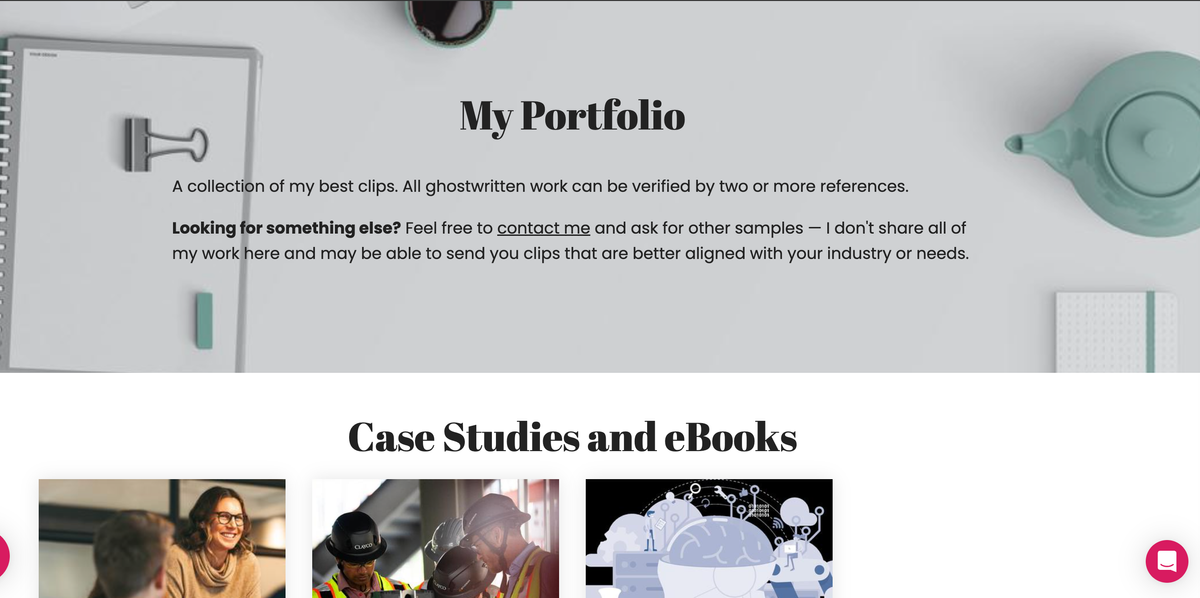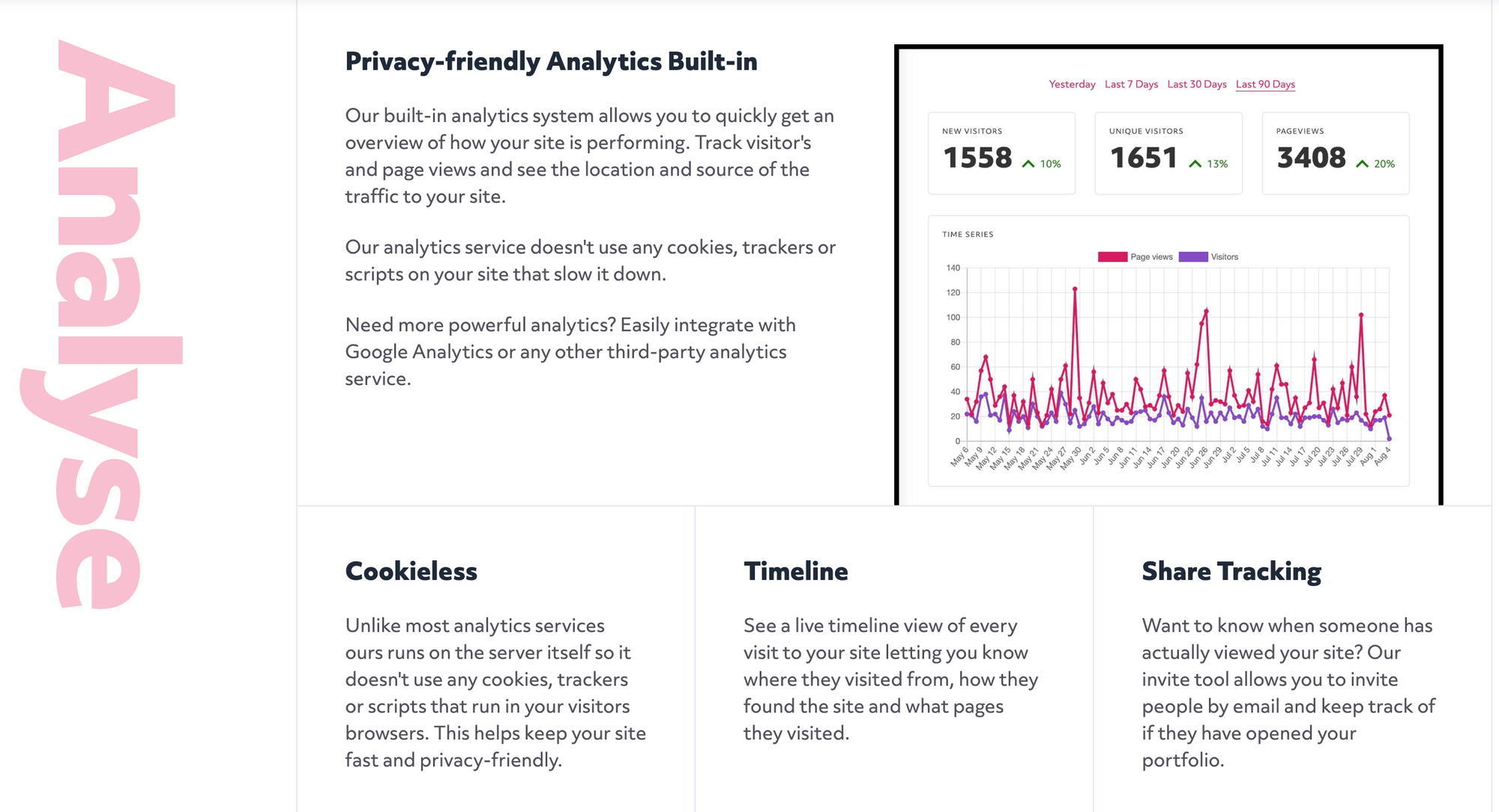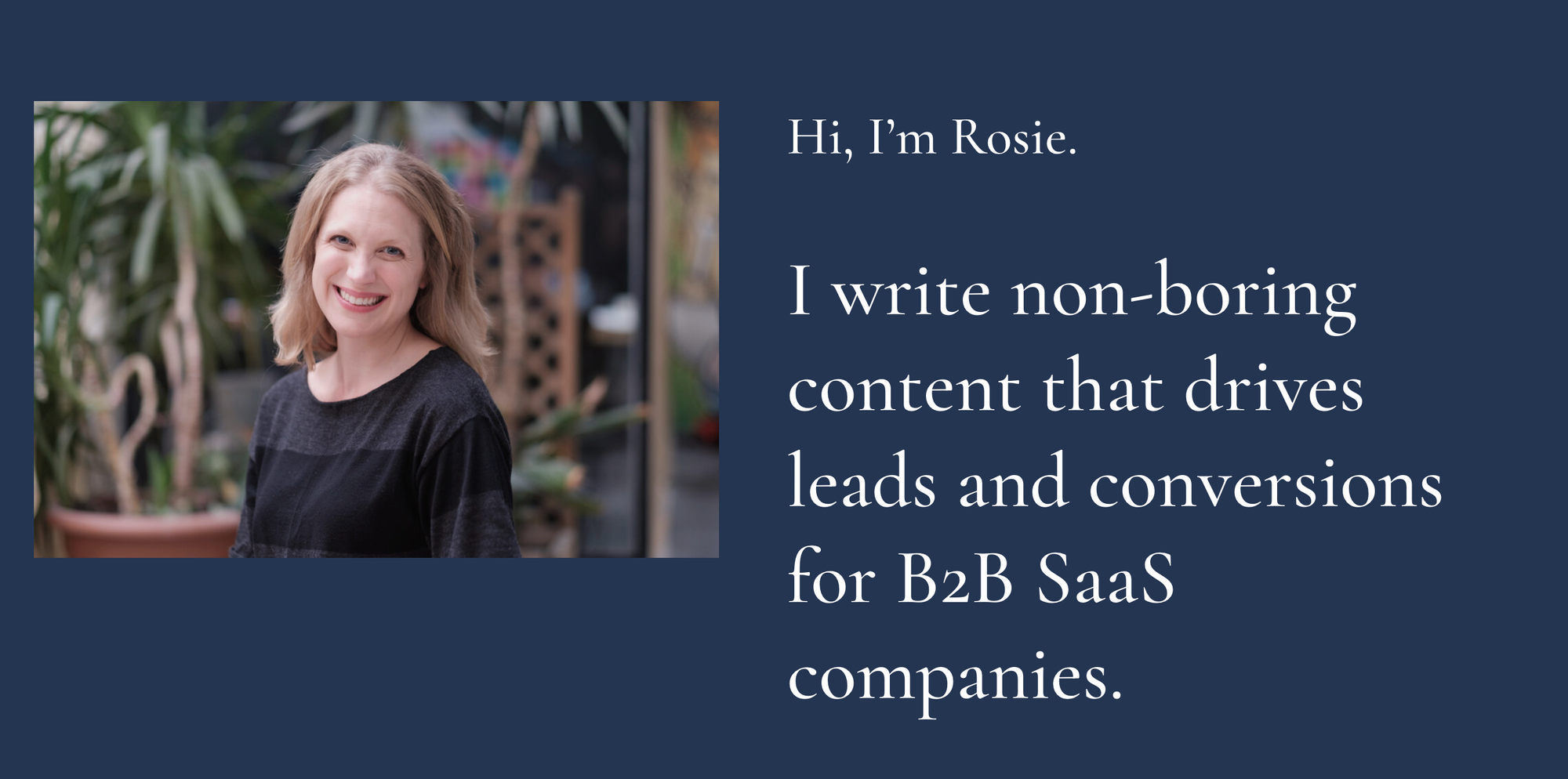How to Build a Freelance Writing Portfolio (Tips & Examples)
Stop treating your portfolio like a storage unit — make it your best sales pitch instead.

As a freelance writer, your portfolio is your ticket to landing dream clients. Nowadays, you need a portfolio website that doesn’t just show your work, but sells it.
After nine years of reviewing portfolios as an editor and maintaining my own as a writer, I've learned what makes clients hit that "contact" button. I've also reached out to the community to ask fellow freelancers what makes a stellar writing portfolio, coming away with a nice set of tips to implement for myself too!
Building a winning portfolio is easier than it seems, even if you’re just starting out. Here’s how to create one that both looks professional and wins new clients who value your expertise, step-by-step.
Do You Need a Portfolio?
Let's address the elephant in the room — do you actually need a fancy portfolio website to land clients?
Reality check: some of the most successful freelance writers I know use nothing more than a Google Doc containing a few choice links. And you know what? It works perfectly for them.
Take David Broderick, a freelance writer and community moderator for Top of the Funnel. He puts it perfectly:
Don't wait until you've got the perfect portfolio site to start pitching for work. I've been freelancing full-time over four years now and my portfolio is just a Google Doc. I don't even send that to potential clients anymore, to be honest – just 3-4 links to the most relevant stuff I've written. So, while I'm sure a banger portfolio helps, you deffo don't need one!
The most important thing? Getting started and putting your work out there.
That said, if you do want to create a more comprehensive portfolio (which can help, especially in certain niches), let's talk about how to do it right.
What to Include in Your Portfolio
Let's start with the foundation. Your portfolio needs three key elements:
1. A Clear Value Proposition
Remember that time you landed on a website and couldn't figure out what the person actually did? Yeah, let's not do that. Your homepage should immediately answer:
- Who you are (your name and face)
- What type of writing you specialize in (Is it short-form copywriting? Long-form content writing? SEO writing? Ghostwriting? etc.)
- Who you write for (Is your target audience B2B, B2C, or DTC? What industries or writing niches?)
- What problems you solve for potential clients
For example, from my website:

"B2B SaaS content writer, ex-journo — and your next content partner. I help B2B SaaS companies tell stories that matter…whether that’s through blog posts, case studies, ebooks, or something else entirely, I'm here to help.”
2. Curated Writing Samples
This should live on your portfolio page (yourdomain.com/portfolio). This isn't your personal library — it's your highlight reel of your best work. Choose approximately 6-10 pieces of high-quality, published work that showcase your writing skills in your target niche. For each piece, include:
- The client or publication
- Your role in the project
- The impact or results (if you have them)
- Optional: Your process (this is the kicker that most writers skip, more on this later)

"Pair each piece with your result and testimonial," says Priscilla Tan, freelance content writer. "If you don't have them, share your process instead. It gives you the chance to show off your strategic skills."

But how do you choose your best samples?
For freelance website developer Sarah Schumacher, it comes down to one thing: your goals.
"Only show examples of work you want to do more of," she says.
Belinda Roozemond, B2B SaaS content writer and strategist, agrees that the general rule of thumb is to choose pieces that align with who you want to write for. However, she personally adds clips that she loves the most.
"It’s more important to me to show that I love what I do and what I am most proud of," said Belinda, reminiscing on a time someone personally messaged her a thank you for writing a particular piece. "So tl;dr, I'd say, add pieces you're proud of."
3. You
Your portfolio should open a window into your personal brand, showcasing who you are as a professional and why clients should choose you. This is your chance to make a personal connection and set yourself apart from the crowd.

Here’s what to include to make your "you" factor shine:
- Your background and expertise
- Your writing process and how you work with clients
- Links to your client-facing social media (i.e. your LinkedIn, Twitter, etc.)
- A contact form and/or your email address as a clear call-to-action
- A bit of personality in your bio, headshot, or About page
Do: Categorize your writing samples
Belinda advises that writers implement some sort of structure to their portfolio.
"Definitely categorize your portfolio in some way. Mine is split between blog posts & long-form guides and case studies & customer success stories," Belinda says. "If you write for several niches, you could also split additionally by niche."

Nupur Mittal, another freelance writer, agrees that your portfolio should categorize work in a way that makes it easy for your prospects to see the value you bring to the table.
"You might have the best samples but if the client has to do the legwork of finding the relevant pieces, you might risk losing a potential collaboration," Nupur shares. "Categorize your samples in a way that makes sense to you. It can be by content formats (listicles, how-to, in-depth guides), niche (email marketing, video marketing, SEO), or content types (newsletter, blog posts, case studies)."
Nupur built her portfolio in Notion and created multiple views showing samples from each niche, making it obvious which industries she writes for.

Do: Add client testimonials
Few things build trust faster than hearing from satisfied clients. Build a testimonial page or place those testimonials right on your home page for maximum effect.
"Collect and add as many testimonials as you can," says Nupur. "It doesn't even have to be proper testimonials. Client praised you for your exceptional project management skills? Add it. A LinkedIn comment about how your writing set the standard? It goes there too. Every little validation matters. So, don't shy away from showing it to the world. You never know who might be paying attention."
I recently started collecting testimonials for my website using Senja, a tool purpose built for that. It makes it super easy for clients to submit testimonials and then with a single approval, I can send those right to my website widgets.

If you’re just starting and don’t have client testimonials, ask colleagues, collaborators, or mentors to provide a character reference that emphasizes your work ethic or writing ability.
Do: Build trust
Prit Centrago, a freelance content marketer, has connected with plenty of HR professionals, content managers, and heads of content. He says there's one thing everyone consistently looks for in a portfolio: Trust.
"Clients want to know you can actually deliver the results they are after," says Prit. "So, if you want to build an outstanding freelance writing portfolio that converts, your main goal should be to build that trust."
According to Prit, you can do just that:
- Clearly showcasing work in the same niche or industry as your prospect.
- Having a professional-looking website without too much clutter. ("Just listing your top (latest) writing samples for each category is enough," says Prit.)
- Showcasing client testimonials and reputed brands for which you've worked in the past.
- Most importantly, showing the real impact and results of your work with past clients.
Don't: Include every article you've ever written
You know how satisfying it is when you finally clean out that one kitchen junk drawer that's been collecting random stuff for years? Your portfolio deserves the same treatment. Just because you wrote something five years ago doesn't mean it belongs in your showcase.
Think about it — when a potential client lands on your portfolio, they're probably pressed for time. They don't need to see that listicle you wrote about cat memes in 2018 (even if it was absolutely hilarious and I'll high five you for it) or every single tweet thread you've ever crafted.
Instead, think curator, not collector. Choose pieces that:
- Showcase your expertise in your target niche
- You're particularly proud of
- Demonstrate different writing styles or formats you excel in
- Have measurable results or impact
- Are recent enough to be relevant
Remember: Quality over quantity. Three stellar pieces that perfectly match what your dream clients need will serve you better than 30 random articles.
Don't: Worry about fitting into a mold
Aka, make it personal!
Just like I let my love for custom mechanical keyboards show on my website, let your personality shine through — professionally. And don't be afraid to break some "rules" along the way.
Take Brinda Gulati, a successful freelance writer who refused to tone down her website's artistic flair, despite plenty of advice to the contrary.
"In my early days, I got a lot of advice to nix the hard-to-read fonts and artistic illustrations to make my offer clearer," she shares. "I didn't do ANY of that and three months ago, I got a direct message from a client I wanted to work with THROUGH my website form, saying he thought it was cool."

Her experience perfectly captures why authenticity matters: "For some, an artsy website may be a block; for others, it's exactly the reason they'd want to work with me."
Just like Brinda, your unique approach might be exactly what makes you memorable to the right clients. Share what makes you you without worrying too much about fitting into some predetermined professional mold.
Building a Freelance Writer Portfolio When You’re Just Starting Out
No clips? No problem. Everyone starts somewhere. Here’s how to make your portfolio shine even if it’s looking a little sparse:
- Create spec pieces: Write sample blog posts or articles in your target niche. Make them real — research thoroughly, follow industry standards, and showcase your writing ability.
- Guest post: Look for industry blogs that accept guest posts. This gives you both clips and visibility. Medium or Substack are also options.
- Volunteer: Offer your skills to nonprofits or local businesses in exchange for a byline.
- Highlight transferable skills: If you’re pivoting to a writing career, showcase past work that demonstrates your expertise, even if it’s not writing-specific.
Creating a Professional Writer Website
Yes, a hosted website with a domain name looks more professional to prospective clients than a free site or a Google Doc. As Tom Dixon, freelance content marketer, says, pay the extra to bring your own domain to your site.
"I think the domain is really just a first impression thing. It feels more polished and professional," says Tom. "Like showing up on an introductory Zoom call with your hair combed. It’s a small detail, and your hair doesn’t have anything to do with your abilities, but it gives off a better first impression."
However, if you're just starting out, online writing portfolio platforms like Authory, JournoPortfolio, and Clippings.me offer solid free plans.

For something more customizable, consider using a website builder like Squarespace, Wix, Webflow, or WordPress — you can start with a pre-made template so it’s less daunting. Even a one-pager site on Carrd, which offers custom domain hosting for just $19 per year, could work – like it does for freelance writer Thomas Hilton. In a pinch, you could design a Notion site or a Canva microsite.
A long, long time ago, I started with Contently.com (before they stopped offering public portfolio sites), then moved to Wix, and now I host on JournoPortfolio (paid). Wix was overpowered for my needs, and the upgraded analytics that come with JournoPortfolio have been well worth the switch for me.

Prioritize Skimmability
Busy clients don’t have time to wade through every article you’ve ever written. They want quick answers:
- Who are you?
- What do you write?
- Why should they hire you?
Pro Tip: Keep your design clean and simple. Focus on UX — user experience.Use bold text, headers and categories, and bullet points to make your portfolio easy to navigate. If clients can’t find what they’re looking for in under 10 seconds, they’ll move on.
Go the Extra Mile
Want to make your portfolio unforgettable? Add personal touches:
1. Describe Your Process
Clients want to know not just what you’ve done but how you do it. By outlining your process, you demonstrate your expertise and professionalism. For example:
- “I conducted in-depth competitor research and used customer interviews to craft this landing page, resulting in a 25% increase in conversions.”
- “For this white paper, I worked closely with the client’s content marketing team and internal SMEs, translating complex technical topics into an engaging narrative.”
Tom tries to include a bit of context with each of his portfolio clips.
"Rather than just a blurb with the intro to the article, I would give some data about how the piece performed, or how it fit into the client’s strategy, or something unique about a challenge I overcame for the piece," he says.

2. Share Results
Numbers speak louder than words. Whenever possible, back up your work with data:
- “This blog post ranked on the first page of Google for its target keyword within 3 months.”
- “My email sequence helped a client increase their open rate by 45% and sales conversions by 15%.”
If you don’t have metrics, consider adding qualitative results, like feedback from your client or the impact your work had on their brand voice or messaging clarity.
3. Include Your Pricing
Save yourself (and your prospective clients) the dreaded back-and-forth email dance by displaying your starting rates or packages on your portfolio site. While it might feel risky, this transparency helps filter out clients who can’t afford you and attracts those ready to invest. If you’re worried about scaring off potential clients, frame it tentatively with your starting rates:
- “Starting at $500 per blog post”
- “Long-form content starts at $0.50/word”
- “Comprehensive website copy packages starting at $3,000”
Bonus: This shows confidence in your value and weeds out budget hagglers.
4 Stellar Freelance Writing Portfolio Examples
Looking for inspiration? Here are X real-life examples of writer portfolios to get your creative juices flowing.
1) Rosanna Campbell - B2B SaaS Writer
Rosanna's portfolio home page tells you immediately what she does.

Scroll down, and you'll find glowing client testimonials, her starting pricing, and her contact form.
Her portfolio page is a simple list of links, categorized into Blog Posts and Reports/E-books.

Here's what Rosanna has to say about her portfolio:
In general, when I pitch for new work, I'll include 2-3 of the most relevant pieces I've done lately, instead of sending a link to my portfolio. That way, I make sure that I'm only sharing work that's 100% relevant to the gig I'm pitching for. So, my portfolio is a bit of an afterthought - it's usually only seen by a warm lead after we're already in discussions. My main goal is just not to put them off if they're interested in working with me.
For my portfolio, I include the work that I'm most proud of, the pieces that have performed best, and the projects that reflect the type of work I specialize in (journalistic, interview-led articles and data-driven reports for B2B SaaS)
I use a really simple format so I can quickly update it myself - this becomes more important if I decide to narrow down or tweak the niche I'm currently targeting. It also makes it very easy for leads to see the types of project I work on.
Her website is a case study in portfolio simplicity done right!
2) Kiran Shahid - B2B Content Writer
Kiran's website also offers her value proposition front and center:

On her home page, Kiran talks about the three kinds of deliverables she creates: blog posts, case studies, and ebooks/whitepapers.

Her portfolio page intersperses testimonials with writing samples categorized into the different niches she's written for.

Here's what Kiran had to say about her portfolio:
Two things that work really well are the social proof and categories. Social proof in the form of logos and client testimonials reinforces my credibility and shows potential clients I'm reliable to work with.
Side note: it always helps to add social proof with actual names and images.
Secondly, categories help me showcase how I've worked with clients in different niches and showcase my expertise.
3) Scaling Rad Content - Sneh Ratna Choudhary
Sneh answers the portfolio question with a two-pronged solution: tailored Canva "resfolios" for each prospective writing client, and a publicly available landing page portfolio for her repurposing services:
I picked Canva over a regular writing portfolio site because I wanted to do more than just display links. As a content marketer/manager (not just a freelance writer), I wanted to visually highlight outcomes and metrics upfront. This sets expectations — clients see me as an extension of their team who delivers results and loop me in other projects that are higher value than straight up writing blog posts.
Her resfolios explain process and results for all of her key projects.

Everything is clickable and interactive, encouraging prospects to engage and open links.

"Clients love it," Sneh says. "It's easy to navigate different content styles, organized in a digestible format, with clear metrics showing long-term value potential."
Meanwhile, her public-facing portfolio is a one page website that opens with her bold differentiating value proposition:

Scroll down and she lists clients, testimonials, and her most recent work:

She also includes her pricing packages, process, and FAQs. Finally, she has a little About Me section, helping prospects get to know the content marketer behind the portfolio.

4) Elise Dopson
Elise's portfolio combines professionalism and personality to build trust and show that she's a freelance B2B writer worth hiring.
Immediately, her portfolio explains what kind of services she offers and who they're for:

Pairing this value prop with recognizable logos of companies like HubSpot and Shopify Plus builds instant credibility.
Next, Elise's "Why I Get Hired" section goes beyond a traditional “About Me” blurb by mixing accomplishments with personality. She highlights unique selling points, such as her SEO expertise, product tie-ins, and an unblemished track record for hitting deadlines. Adding a personal note about running affiliate sites and foodie TikTok/Instagram accounts makes her relatable and reinforces her real-world experience.

Elise categorizes her portfolio into specific niches, like Ecommerce, retail + DTC, Marketing, and Creators + Entrepreneurship, making it easy for potential clients to see her breadth of expertise while navigating her work.

Elise’s portfolio doesn’t just describe her work; it shows the impact. For instance, in her Shopify content refresh, she includes tangible results. By pairing these metrics with a visual (traffic growth chart) and following them up with client testimonials, she makes her success undeniable.

This is a perfect example of how to use your portfolio to prove your value!
The Writer Portfolio Checklist
Before you hit publish, make sure you have:
- A clear, compelling homepage that states your value proposition
- At least 6-10 carefully chosen samples that showcase your best writing
- A professional platform that presents your work well
- Your contact information prominently displayed
- A touch of personality that makes you memorable
Remember, your portfolio is a living document. You need to keep it updated as you write more, and as your rates and processes change. Keep refining, keep learning, and most importantly, keep creating.
Need more guidance on your freelance journey? Subscribe to cmd + create, my monthly newsletter packed with practical tips and behind-the-scenes insights from deep within the freelance trenches.




